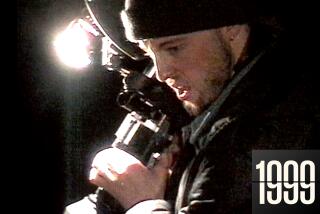Evidence of an Era
ovie scholars say the last film noir was released in 1959, but a raft of contemporary directors probably begs to differ: “Red Rock West,” “Reservoir Dogs,” “The Last Seduction,” “One False Move” and “Traveller” are but a few recent releases that rework the tenets of film noir, a style that shows no sign of disappearing.
A quick perusal of “Crime Scenes: Movie Poster Art of the Film Noir” (Lawrence Bassoff Collection Inc., $35), a book of color reproductions of vintage noir posters that arrives in bookstores Saturday, reveals how much the sensibility is still with us. Taking us into a world where nice guys finish last, the streets are always wet with rain and the best accessory for a slinky evening gown is a revolver, “Crime Scenes” celebrates a school that’s left its mark on everything from low-budget comedies like “Swingers” to big-budget neo-noirs like “L.A. Confidential.”
Based on the collection of Lawrence Bassoff, whose holdings have been seen previously in the 1995 book “Errol Flynn--The Movie Posters,” “Crime Scenes” includes promotional artwork for 100 film noirs from 1941 through 1959.
“This art has only been seen by collectors,” says Bassoff, on his decision to publish the book. “I also hope to put film noir on its feet for a broader audience. There are many wonderful books on film noir, but they tend to be scholarly studies; anyone could flip through ‘Crime Scenes,’ though, and immediately understand the spirit of these films.”
Born in 1951 in New York, Bassoff grew up watching movies on TV with his father. When he was 19, he got a summer job changing air-conditioner filters in Manhattan movie theaters, and he was given a poster from “A Fistful of Dollars.”
Two years later he stumbled across the Memory Shop, a Manhattan store stocked with thousands of reasonably priced movie posters, and he was bitten by the collecting bug.
“My first purchase was a poster from ‘The Adventures of Don Juan’ that I got for $15,” Bassoff recalls. Throughout the ‘70s, he continued to build his collection, acquiring things, he says, “based on whether I liked the movie. My books focus on the classics, but I love the full range of movies.”
Film noir has its roots in German Expressionism, an aesthetic introduced to Hollywood by such emigre directors as Fritz Lang, Edward Dmytryk and Billy Wilder, who fled Hitler. That the German Expressionist influence apparent in noir films wasn’t carried through in the promotional graphics is indicative, Bassoff says, “of how unself-conscious they were in the making of these films.”
“The big studios released up to 50 movies a year and had in-house art departments; noir posters are never signed, and they reflect the look of the studio more than the film being promoted,” he says.
“These were inexpensively made mass entertainments, and the posters were designed to sell the stars of the films, rather than promote a cinematic school. Crime films weren’t taken as seriously then as they are today, and though there were exceptions, such as ‘Sunset Boulevard’ and ‘The Asphalt Jungle,’ the intellectual avant-garde didn’t rush out to see them.”
Bassoff’s collection now has approximately 10,000 pieces dating from 1938 through the present, and he happily reports that “the market’s gone through the roof since I began collecting.”
“Prior to 1989, you could get most of the posters in the book for $30, and if you paid $100 for a poster, people thought [you] were crazy. Then in 1989, Barry Vilkin started an auction house in Beverly Hills that launched the movie poster craze. There are a dozen major auctions of this material around the world every year now, and the most sought-after posters are from ‘Out of the Past,’ ‘Leave Her to Heaven’ and ‘This Gun for Hire,’ which is the Mona Lisa of movie posters. There are maybe 150 of them in circulation, so they come up at auction fairly regularly, and they sell for about $8,000.
“The little guy’s been dealt out by the rise in value of posters, but there are still bargains out there if you’ve got a good eye.”
Michael Schwartz, director of entertainment memorabilia for Butterfield & Butterfield, points out that the market exploded “for the simple reason that people finally learned these posters were available. Since Barry Vilkin’s auction of 1989, there’s been a plethora of similar auctions, all of which have been well publicized. The market reached an unprecedented peak in March when Sotheby’s New York sold a one sheet of Boris Karloff’s 1931 film, ‘The Mummy,’ for $450,000.”
Despite the fact that horror film posters outpace film noir in the marketplace, Bassoff is at work on “Crime Scenes II,” which deals with post-noir of the ‘60s and ‘70s and neo-noir of the ‘80s and ‘90s, such as “L.A. Confidential.”
“The thing that distinguishes post-noir films like ‘Chinatown’ or ‘The Grifters’ from vintage noir is the self-consciousness with which they were made,” Bassoff says.
“Directors of the ‘40s and ‘50s didn’t know they were making film noir; in fact, the concept didn’t exist until 1946, when French critic Jean Pierre Chartier coined the term.”
More to Read
Sign up for our Book Club newsletter
Get the latest news, events and more from the Los Angeles Times Book Club, and help us get L.A. reading and talking.
You may occasionally receive promotional content from the Los Angeles Times.









